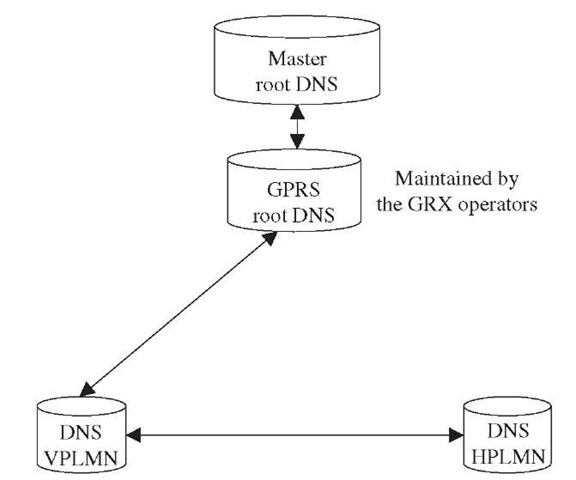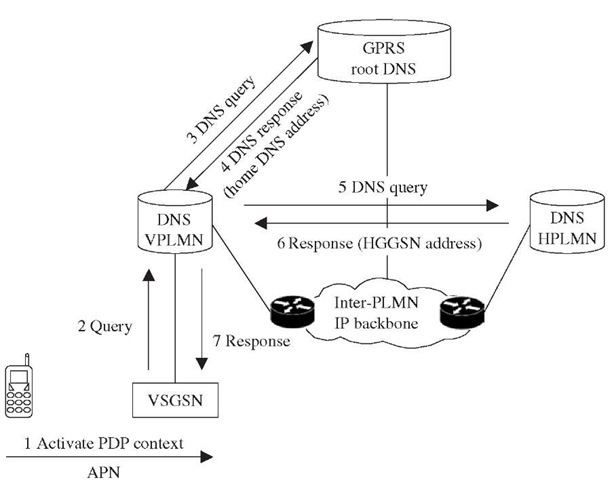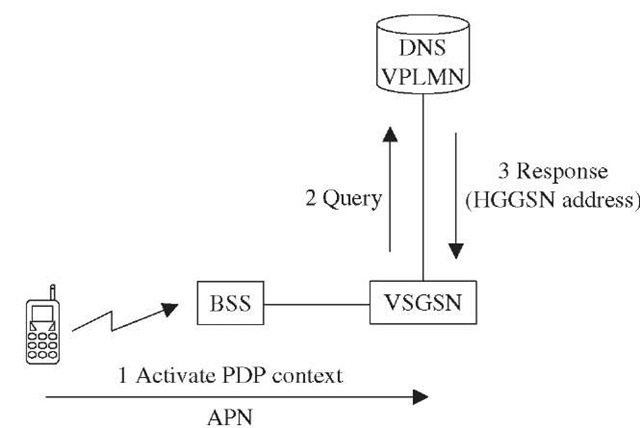GPRS and DNS
Domain name system (DNS) functionality is used for mapping logical names to IP addresses in the GPRS intra- and inter-backbone network. Each PLMN has its own local DNS functionality. Typically, two mirrored DNS servers, i.e., primary and secondary DNSs, are available to ensure uninterrupted service. In addition, the inter-PLMN backbone also has DNS functionality, i.e., root DNS. SGSNs communicate with their own local network DNS for mapping. The DNS of different PLMNs talk to each other either directly or through a DNS root maintained by GRX operators or a master DNS maintained by the GSM Association.
Figure 7-7 shows the topology and communication flow of DNS systems for inter-PLMN mapping. The master root DNS server holds the records of the responsible domain of each operator’s DNS server. Each GRX operator periodically synchronizes with the master root DNS to its own root DNS server. DNS to DNS communication uses IP to transfer information.
Figure 7-7 GPRS DNS topology and hierarchy.
Note that the GPRS DNS system is a private network. It has no interaction with the Internet’s DNS system.
APN resolution using DNS in the HPLMN
In this case, a roamer is attached to a VPLMN SGSN (VSGSN) and activates a PDP context, using a GGSN in the home network. The VSGSN needs to know the HGGSN address to initiate the create PDP context procedure. The VSGSN uses an APN provided by the user to resolve IP addresses with the help of DNSs. Figure 7-8 illustrates APN resolution procedure in detail.
The procedure consists of these steps:
1. A roamer currently attached to the GPRS network activates a GPRS service. The MS sends an activate PDP context message to the serving SGSN. This message may or may not contain an APN name corresponding to the services the user wishes to access. Let us assume that the APN is my.isp.com.
Figure 7-8 APN resolution using DNS in the HPLMN.
2. The VSGSN inserts its own operator identifier (e.g., mnc011.mcc111.gprs) to make a complete logical name, i.e., my.isp.com.mnc011.mcc111.gprs, and queries its own local DNS. If the APN my.isp.com is not known to the local DNS, it responds back indicating failure to resolve the APN.
3. The VSGSN now inserts the roamer’s home operator identifier’ (e.g., mnc022.mcc222.gprs) and sends a query to the root DNS (via its local DNS) in the inter-PLMN backbone.
4. The GPRS root DNS replies by sending the HPLMN DNS address to the VPLMN DNS.
5. The VPLMN DNS asks the HPLMN DNS for the GGSN address.
6. The HPLMN DNS resolves the APN and responds back to the VPLMN DNS.
7. The VPLMN DNS replies to the VSGSN with the HGGSN address.
8. The VSGSN initiates the create PDP context procedure with the HGGSN.
APN resolution using DNS in the VPLMN
In this case, a roamer is attached to a VSGSN and activates a context using a VGGSN. Figure 7-9 shows the steps involved in resolving the APN:
1. A roamer currently attached to the GPRS network activates a GPRS service. The MS sends an activate PDP context message to the serving SGSN. This message may or may not contain APN name corresponding to the services the user wishes to access. Let us assume that the APN is my.isp.com.
Figure 7-9 APN resolution using DNS in the VPLMN.
2. The VSGSN inserts its own operator identifier (e.g., mnc011.mcc111. gprs) to make a complete logical name, i.e., my.isp.com.mnc011mcc111. gprs, and queries its own local DNS.
3. The APN my.isp.com is known to the local DNS. It responds back with the VGGSN address, which is required to serve the roamer request.
4. The VSGSN then activates the create PDP context procedure with the GGSN.



